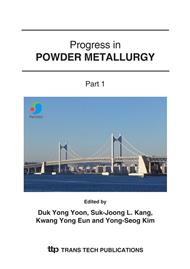p.613
p.617
p.621
p.625
p.629
p.633
p.637
p.645
p.649
Influence of Tempering Temperature and Microstructure on Wear Properties of Low Alloy PM Steel with 1-2 % Ni Addition
Abstract:
The effect of tempering temperature and microstructure on dry sliding wear behavior of quenched and tempered PM steels was investigated. For this purpose, atomized iron powder was mixed with 0.3 % graphite and 1-2 % Ni powders. The mixed powders were cold pressed and sintered at 1200°C. The sintered specimens were quenched from 890°C and then tempered at 200°C and 600°C for 1 hr. Wear tests were carried out on the quenched+tempered specimens under dry sliding wear conditions using a pin-on-disk type machine at constant load and speed. The experimental results showed that the wear coefficient effectively increased with increasing tempering temperature. With increasing Ni content, the wear coefficient slightly decreased at all tempering temperatures due to the high amount of Ni-rich austenitic areas.
Info:
Periodical:
Pages:
629-632
Citation:
Online since:
January 2007
Authors:
Keywords:
Price:
Сopyright:
© 2007 Trans Tech Publications Ltd. All Rights Reserved
Share:
Citation:


